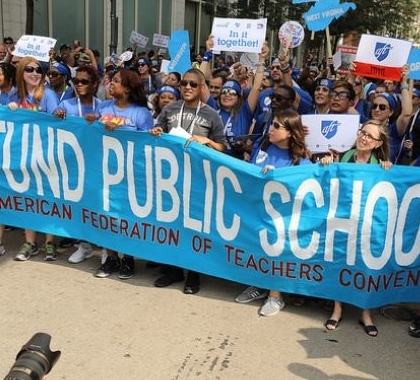Looking to leverage the momentum of successful teacher strikes in California, Arizona, Oklahoma, West Virginia, and elsewhere over the past year, the American Federation of Teachers has launched a six-figure advertising campaign claiming that 25 states “spend less on K-12 education than before the Great Recession” and calling attention to “massive shortfalls in education investment.” Based on its own study, “A Decade of Neglect,” the AFT has scheduled 90 events, including “informational pickets, town hall meetings, forums, marches, protests and lobby days all over the country.” The union has even scheduled a town hall in Los Angeles, though, according to its report, California is one of the states that has boosted spending since the recession. Nonetheless, the union claims that Golden State schools don’t have enough nurses, librarians, counselors, and paraprofessionals.
In fact, the new initiative won’t miss a single state. Speaking before the House Committee on Education and Labor in February, AFT president Randi Weingarten insisted that more education spending was needed. Teachers aren’t paid enough, she said, stressing the importance of finding “real, sustainable solutions to the disinvestment in public education and services.” She claimed that the AFT’s report exposes “how certain state legislative bodies and governors exacerbated the damage by cutting taxes for the rich at the expense of public schools.”
It may be true that some states are spending less, but there is no national crisis in education funding. The latest figures from the Organisation for Economic Cooperation and Development (OECD), a group of 35 countries that collects and publishes an array of data on its member countries, show the U.S. ranked fourth in spending, after Norway, Switzerland, and Austria. In fact, the U.S. spends about 30 percent more than the average OECD country, and 20 percent more than either Germany or Canada, with much worse outcomes. On the most recent Programme for International Student Assessment (PISA), American 15-year-olds ranked 30th in math out of the 35 participating OECD countries.
The problem is not how much the U.S. spends on education—we spend a lot—but how the money is allocated. Researcher and economics professor Benjamin Scafidi found that between 1950 and 2015, the number of teachers increased about 2.5 times faster than the number of students. The hiring of other education employees—administrators, teacher aides, counselors, social workers—rose more than 7 times faster than the increase in students.
Robert Costrell, a finance expert at the University of Arkansas, reveals that $1,301 per pupil, or 10.6 percent of all education funding, goes toward teacher retirement benefits, up from 4.8 percent of per pupil expenditures in 2004. Whereas states administer teacher pensions, health-care benefits vary by local union contract. Some districts cut teachers’ health benefits off when Medicare kicks in, but others are much more generous with taxpayer dollars. The Los Angeles Unified School District provides the same plush health coverage for retirees as it does for current employees; neither group pays a premium for this union-mandated plan.
The AFT is doing what its members pay dues for: getting as much money into public education as possible. Jon Coupal, president of the Howard Jarvis Taxpayers Association, suggests that California’s taxpayers consider going on strike. He points out that in the 1970s, California’s public schools ranked at or near the top nationally in education outcomes. Yet today, despite spending 30 percent more on a per-student, inflation-adjusted basis than 45 years ago, California’s latest test scores are pathetic. On the 2017 NAEP test, the state ranked near the bottom nationally, with 69 percent of fourth-grade students scoring as nonproficient in both math and reading. Taxpayers rarely complain about shelling out money for public education. But when they are abused, they need to fight back. A taxpayers’ strike would be dicey from a legal perspective; a taxpayers’ march on the state capital is a better idea. The unions have had a lock on the legislature in Sacramento and other state capitals for years now. It’s about time that they heard what taxpayers think about it.
[Originally Published at City-Journal]





